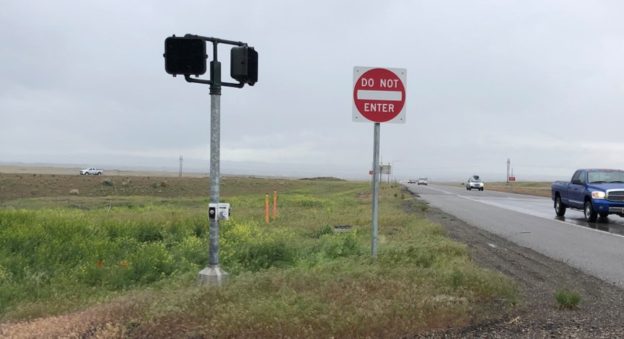By Don Kostelec
April 3, 2020
All beg buttons are push buttons, but not all push buttons are beg buttons.
Keep that in mind as you follow this wonky journey into the world of pedestrian signal actuation.
The COVID-19 pandemic has created good social media fodder about the utility of pedestrian push buttons. One camp sees all push buttons as a bad thing. Some recognize there are locations where it’s the best option. And there are push button technologies necessary for people who are blind or visually-impaired.
The Good
In preparation for this post I sent out a tweet asking folks to identify the differences in the two pedestrian push buttons below. You can see the replies by following the link.
They are the exact same technology in terms of hardware and software. Both are on streets within the City of Boise, which are managed by Ada County Highway District (ACHD). But they serve two different purposes.
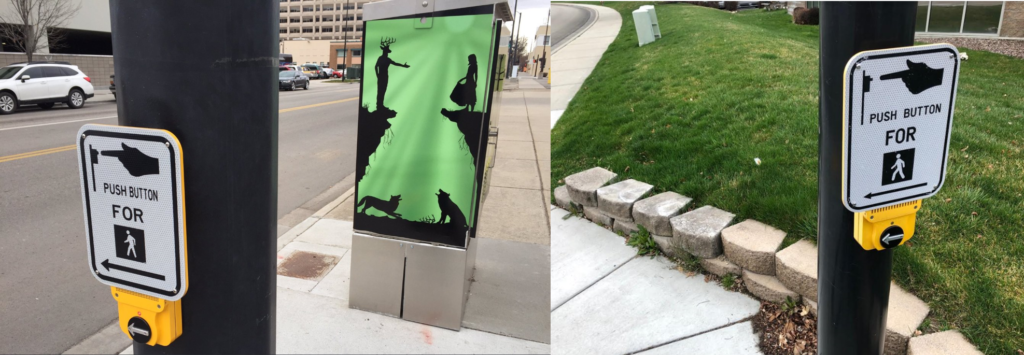
Right: This button is the same technology and provides the same audible cues, but is at an intersection where pushing the button is required by all users to get the walk signal.
The button on the left is at the intersection of 13th Street and Jefferson Street in downtown Boise. In Boise we are lucky that nearly all traffic signals in downtown fixed timing plans. They are programmed in what is called “recall mode.” Recall mode is where the signal phases for motor vehicles and pedestrians are displayed each cycle whether demand exists or not. No vehicle has to trip a loop detector and no pedestrian has to physically push the button.
So why do we have these push buttons downtown? They are there strictly for use by disabled people who rely on them to navigate the downtown area and orient themselves to their desired path of travel. To ACHD’s credit, they implemented this technology at almost every downtown traffic signal and maintain a list of other priority locations identified by their ADA Advisory Committee. These are referred to as “accessible pedestrian signals” or “audible pedestrian signals.” There are design requirements in terms of placement and function, as mandated in by MUTCD Section 4E.09.
The Beg
The button on the right in that image above serves the same function for disabled people but is at a signal where recall mode is not deployed, meaning everyone has to push the button to get a walk signal. It is at the intersection of Parkcenter and Apple in southeast Boise. It’s the beg button we all like to mock.
It’s at an intersection where requiring a pedestrian to push the button to cross Apple is questionable. Parkcenter is the major street with 21,000 vehicles per day at this intersection. The signal cycle that provides green time for Parkcenter allows ample time to provide a pedestrian signal with the green phase to move this traffic. Apple is 65 feet wide from curb ramp to curb ramp, which means the pedestrian signal needs to be 25 seconds or so to provide minimum time for someone to cross.
The problems I see with using the same button technology and signage in the downtown and Parkcenter setting is a person using the sidewalk does not know how to determine when they must push a button and when it is not required.
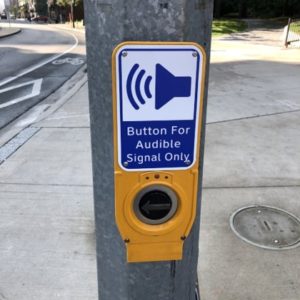
The image at right shows one potential modification to the downtown push button situation. It indicates the button is there for a specific purpose and not required to be pushed to get the walk signal. You might find your local agency reluctant to do this since that sign is not in MUTCD. But you’ll also find local examples where they’ve fabricated signs to address a local condition even if they aren’t in MUTCD. They can do it, if motivated to do it.
The image below shows the next signalized intersection along Parkcenter. The north leg is a private street (Spring Meadow; 800 vehicles per day) and the south leg is a public street (Law; 1,700 vehicles per day). Parkcenter is a major arterial and these side streets serve a relatively minor function in the street network. Spring Meadow (the crossing shown in the left image) serves only a few houses.
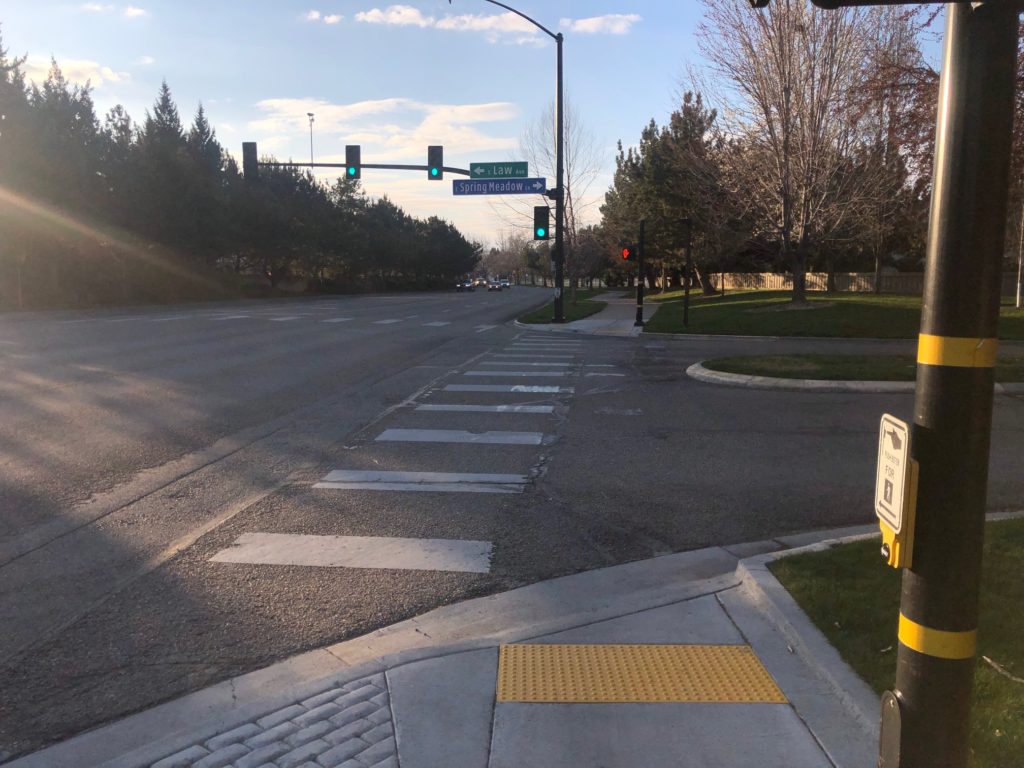
Parkcenter and Spring Meadow in Southeast Boise. (Yeah, lining up a curb ramp with a crosswalk is a hard ask for engineers.)
This situation is one where a pedestrian wishing to cross Parkcenter must push the button to actuate that walk signal. Given vehicle traffic characteristics, this is not an unreasonable request. You’ll scream long and loud to no avail trying to get a traffic engineer to use recall mode in this situation. There simply aren’t enough vehicles approaching Parkcenter from either street to program it with fixed cycle lengths. Even when motor vehicle trip the signal, there are normally only one or two. Pushing the button gives the pedestrian more time than the normal cycle length would give them.
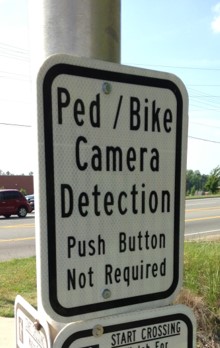
(The problem at the crossing shown in the image above is this crosswalk is part of the Boise River Greenbelt and runs alongside Parkcenter for a mile or so. It shouldn’t require Greenbelt users to push the button given the green time given to Parkcenter, but ACHD loves their Flashing Yellow Arrows, so they make everyone using the Greenbelt beg to cross the street at a substandard ramp. I cross this intersection frequently and never push the button. Few people do.)
While crossing Parkcenter at this location might be acceptable to push the button, such is not the case for crossing Spring Meadow (the street with the crosswalk shown in the left image). The Boise River Greenbelt runs along this side of Parkcenter and has very consistent foot and bike traffic. The signal cycles on Parkcenter are almost always long enough to allow a person to cross but ACHD engineers have chosen to not give the Greenbelt users an automatic walk signal. I observe it frequently and most people ignore the button and cross anyway.
The easiest way to spot a bad application of push buttons is to walk around the downtown area of a city. If the signals require a pedestrian to push the button, then it’s a bad application. If you’re not sure, go to a signal and don’t push the button. If you don’t get the walk signal automatically, then you’re in a beg situation.
We shouldn’t have to beg to cross downtown streets. People shop and tend to carry more things in their arms, which creates a hassle to have to push the button. Downtown areas have more families walking around where parents want to hold hands with their children. Street corners tend to be more crowded which makes it harder to know if someone pushed the button. Downtowns tend to have more disabled people using the sidewalk network and they shouldn’t be saddled with additional requirements in order to move freely about their community. You can argue that accessible signals should automatically provide the audible cues when in recall mode so someone who is blind or visually-impaired doesn’t have to find the button.
If you’re on an advisory committee, downtown business association member, or a citizen wanting to make walking easier in your downtown, then you should request signals be set to recall mode in downtown settings and other mixed-use corridors where pedestrian traffic is heavy. There might still be locations due to vehicle turn volumes and other features that the engineers hold on to the requirement to push a button, but those should be the exception and not the rule.
The beg function also reveals an inherent laziness in the traffic engineering profession. Agencies like ACHD and State DOTs love to tout how they are nimble in adapting traffic signals for congested situations. Not so much when it comes to people using their sidewalks. When ACHD conducted a study along Boise’s Capitol Boulevard someone asked for the signals to be set to recall mode for pedestrians at a major intersection where Boise State University students cross. This was their consultant’s response in rejecting that idea:
- “Putting the intersection on pedestrian recall may make sense when school is in session, but there is not enough demand to warrant it when it is not in session so it should be left as pedestrian actuated.” (Page 52)
Boise State is in session 8 months out of the year. This means in ACHD’s judgment, having enough pedestrian demand to put the signal on recall 66% of the year is not a valid enough reason to send a signal technician out there a couple times a year to re-program the signal. Mind you, this is the same agency that disables school zone speed limit flashers during spring break and summer so motorists are not inconvenienced.
The Ugly
Beyond asinine applications in downtown and park settings, I feel the root of the vitriol directed at push buttons comes in the widespread substandard engineering of their placement. I’ve cataloged dozens of horrific applications during my travels. The piss poor placement of pedestrian push buttons is standard practice.
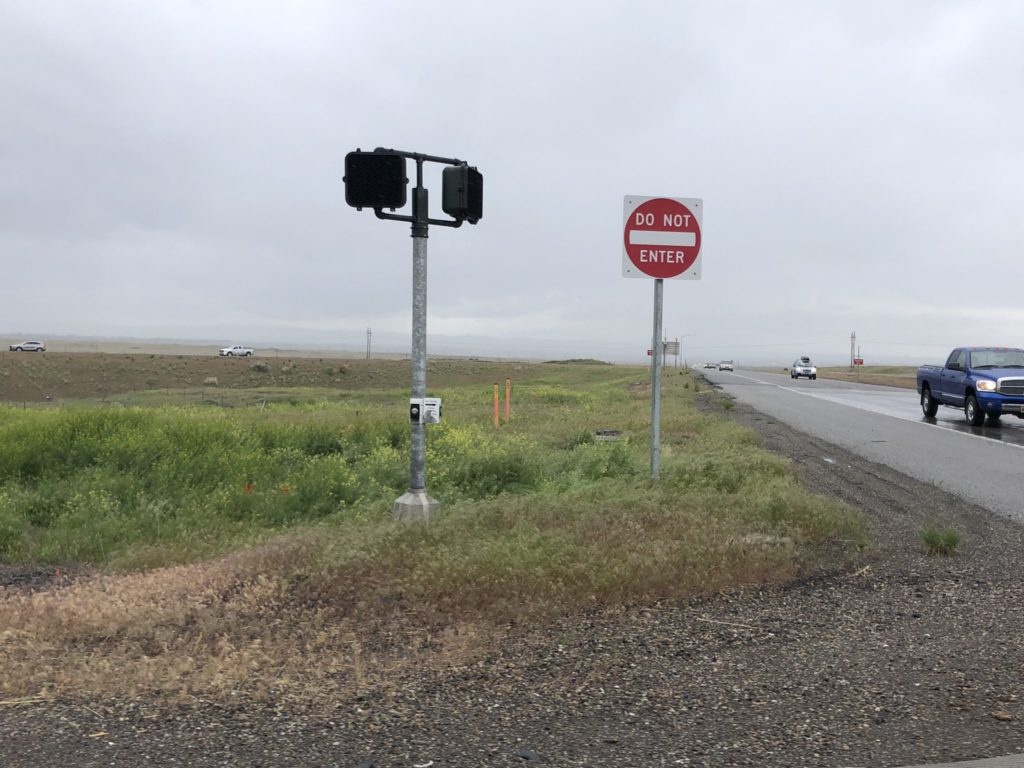
The image below shows several that were reviewed and inspected at many levels by state DOT engineers. My guess is many also involved the use of federal funding, which means FHWA didn’t catch the lackadaisical engineering that led to these situations. Buttons overhanging drainage grates. Buttons more accessible to motorists than pedestrians. Landscaped buffers between the ramp and button by the same agencies that won’t build landscaped buffer between sidewalks and their streets. All are ripe for an ADA lawsuit.
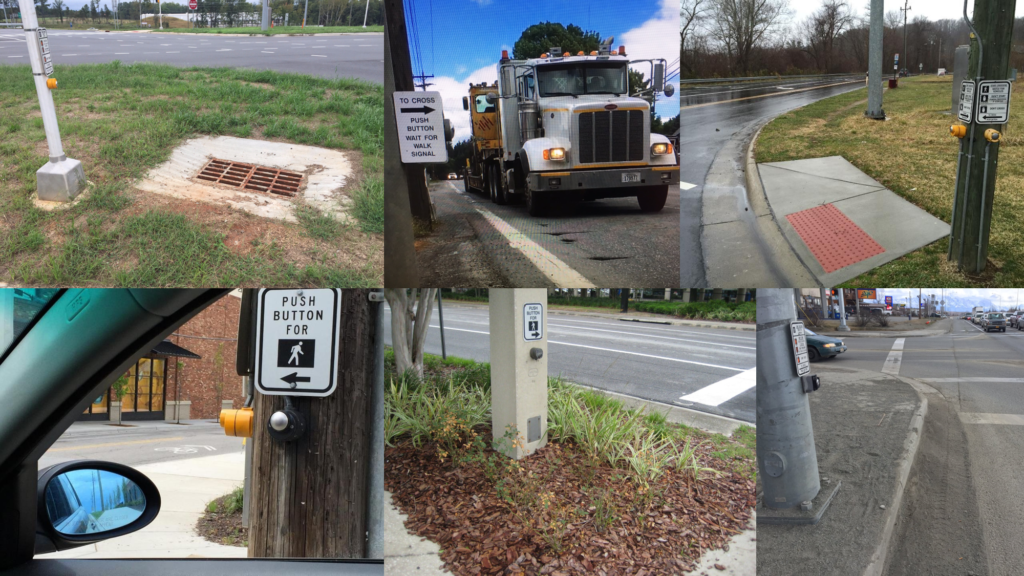
Top middle: Idaho Transportation Department in Bonners Ferry.
Top right: NCDOT at a bus stop in Asheville, NC.
Bottom left: NCDOT at an intersection along Merrimon Ave in Asheville.
Bottom middle: Florida DOT in Tampa.
Bottom right: Alaska DOT in Wasilla.
My all-time favorite comes courtesy of the North Carolina Department of Transportation along NC Highway 112 in Asheville. The video below shows just how lazy their consultants and engineers were in considering the basic needs of pedestrians. You must push this button to get the walk signal. If a person in a wheelchair or parents with a stroller were hit trying to cross this street but did not with a Don’t Walk signal, would the police even investigate the engineering of the push buttons? Would they realize engineering put that person in an unsafe situation and forced the person to break the law to cross the street? Probably not. The pedestrian would likely be blamed in the crash report and it would be just another tragedy chalked up to human error.

